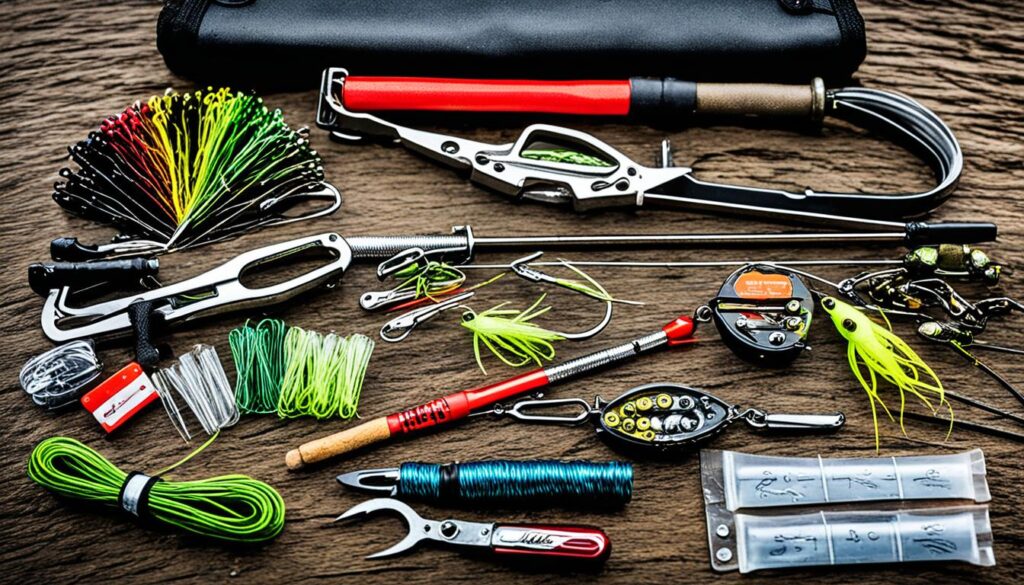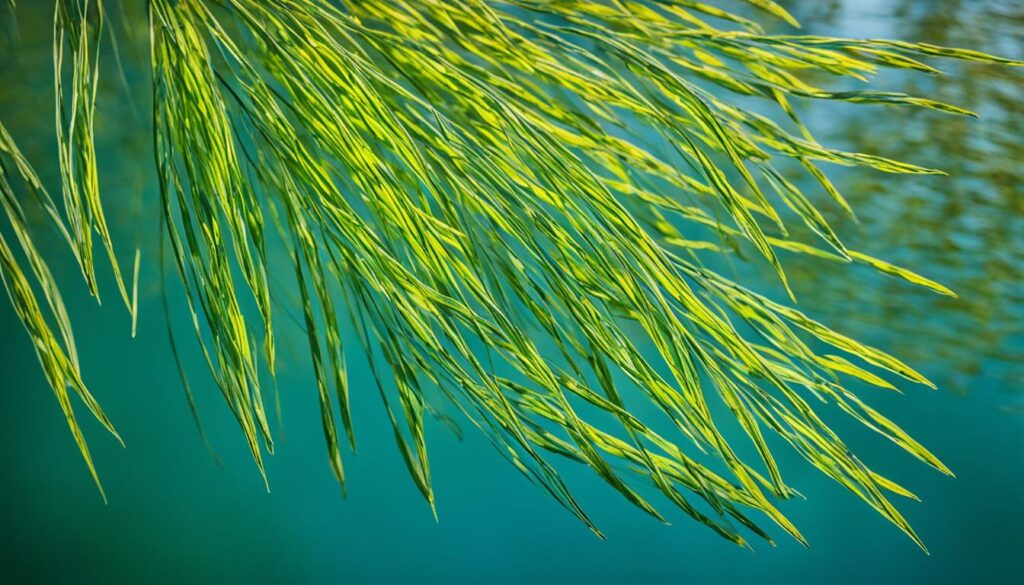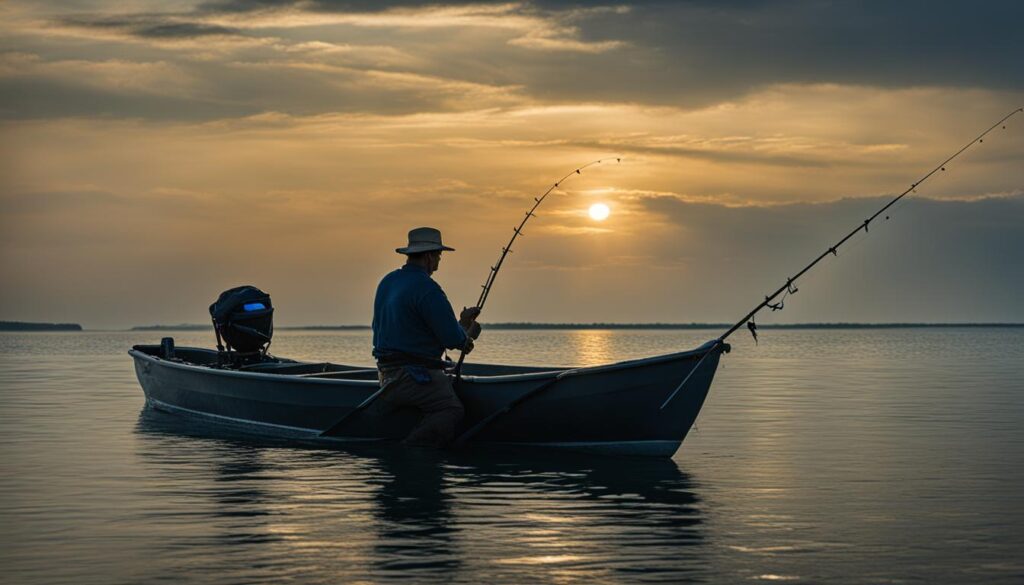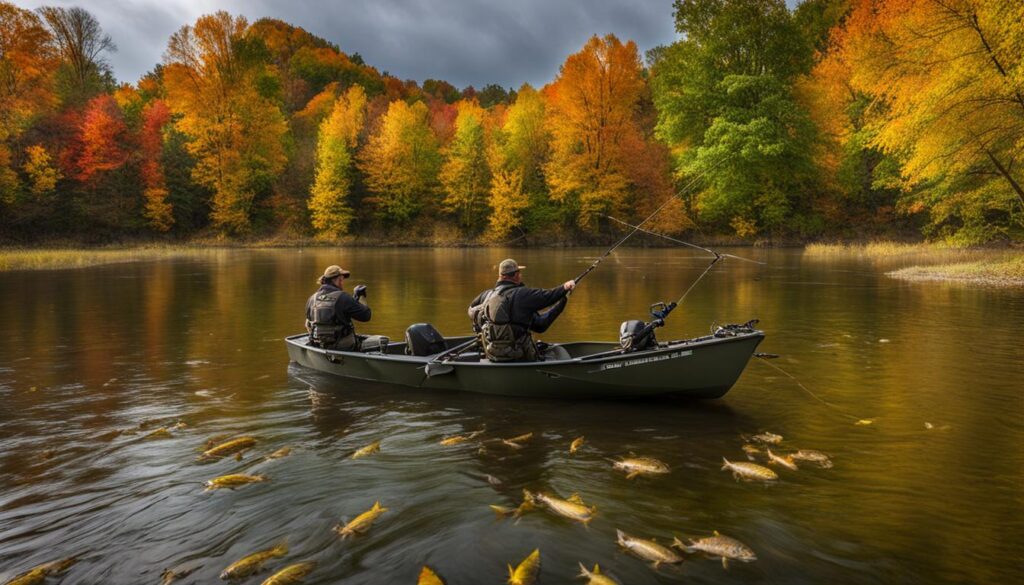Fall is an exciting time for fishing enthusiasts, especially those targeting smallmouth bass. As the temperatures cool and the leaves change colors, these feisty bass are on the move, transitioning to their deep wintering holes. One effective technique that anglers swear by during this season is the use of umbrella rigs. These rigs mimic schools of baitfish, making them highly enticing to hungry bass.
When it comes to fall smallmouth bass fishing, the umbrella rig is a game-changer. Also known as the Alabama rig, this finesse technique allows anglers to cover extensive rocky areas without getting snagged. By imitating a school of baitfish, the umbrella rig creates a feeding frenzy in the water, attracting the attention of smallmouth bass.
- Fall is an excellent time to target smallmouth bass as they transition towards their deep wintering holes.
- Umbrella rigs mimic baitfish and are highly effective in enticing smallmouth bass.
- The umbrella rig, also known as the Alabama rig, allows anglers to cover rocky areas without getting snagged.
- Using an umbrella rig creates a feeding frenzy, attracting hungry bass.
- Stay tuned for expert tips on gear selection, locating transition bass fishing spots, and effective techniques for using umbrella rigs.
Understanding the Umbrella Rig
When it comes to targeting smallmouth bass, the umbrella rig is a go-to tool for many anglers. Also known as the Alabama rig, this finesse rig is designed to imitate a school of baitfish, presenting multiple swimbaits to entice bass. This unique rigging system allows fishermen to cover extensive rocky areas without the worry of getting snagged, making it perfect for exploring transition bass fishing spots.
The umbrella rig consists of a single frame with multiple swimbaits attached, creating a lifelike baitfish scenario that triggers the predatory instincts of smallmouth bass. The strategic placement of the swimbaits gives the illusion of a school of baitfish swimming together, increasing the chances of attracting bites.
This highly effective rig can be used in various scenarios and is particularly successful during the fall smallmouth bass season. The transition period when bass are gathering around their deep wintering holes is an ideal time to utilize the umbrella rig, as it mimics the baitfish commonly found in those areas.
To get a better understanding of how effective the umbrella rig can be, let’s take a closer look at its key features:
Key Features of the Umbrella Rig
- Multiple swimbaits
- Single frame
- Imitates a school of baitfish
- Finesse rig
- Covers extensive rocky areas without snagging
The umbrella rig’s ability to imitate a school of baitfish and cover a large fishing area makes it a versatile tool for anglers targeting smallmouth bass in transition bass fishing spots. It’s important to note that some fishing regulations may limit the number of hooks that can be used on an umbrella rig, so be sure to check the local fishing regulations before heading out on the water.
Next, we’ll dive into choosing the right gear for fishing with an umbrella rig to ensure optimal performance and success.
Choosing the Right Gear
To effectively fish with an umbrella rig, it’s important to have the right gear. Here are some recommendations:
Rod and Reel Setup
A 7’4″ medium-heavy casting rod with a regular action is recommended for fishing with an umbrella rig. This type of rod provides the strength and flexibility needed to handle the weight and movement of the rig, while the regular action allows for better control and sensitivity.
When it comes to the reel, opt for one with a slower gear ratio. A slower gear ratio, such as 5.4:1 or 6.2:1, allows for a smooth and steady retrieval, preventing the rig from spinning or tangling. This gear ratio is ideal for maintaining control and properly working the swimbaits on the rig.
Line Choice
Using lighter-than-usual line can enhance the performance of the umbrella rig setup. A monofilament line with a test strength between 10 to 15 pounds is recommended. Lighter line helps to maximize the action and movement of the swimbaits, improving the overall effectiveness of the rig.

| Recommended Gear for Umbrella Rig Fishing | Rod | Reel | Line |
|---|---|---|---|
| 7’4″ Medium-Heavy Casting Rod | Regular Action | Slower Gear Ratio (5.4:1 or 6.2:1) | 10-15 lb Test Monofilament Line |
Locating Transition Bass Fishing Spots
Finding the prime transition bass fishing spots can be a challenge, but with the help of advanced fish-finding technology, it becomes easier. Forward-facing sonar equipped with TargetLock and MEGA 360 imaging can assist anglers in locating fish with precision.
Upgrade Your Fishing Experience
With the latest fish finders for bass fishing, you can take advantage of sonar technology to uncover hidden fish hotspots. Imagine having a virtual underwater view, allowing you to see exactly where the bass are hiding!
Using forward-facing sonar with TargetLock and MEGA 360 imaging, you can explore transition bass fishing spots like never before. These cutting-edge features provide clear visuals of fish movements and pinpoint their exact locations. By spotting fish on your fish finder, you can focus your efforts on the most productive areas and increase your chances of hooking that trophy bass.
| Sonar Technology | Benefits |
|---|---|
| Forward-Facing | See fish activity in real time |
| TargetLock | Lock onto individual fish for more accurate targeting |
| MEGA 360 Imaging | Get a complete 360-degree view of the underwater environment |
Maximize Your Success
Once you’ve located a promising transition bass fishing spot using your fish finder, it’s time to strategize. One effective technique is to spot-lock your boat using an anchor or a GPS-enabled trolling motor. This allows you to stay in the area without drifting away and gives you the opportunity to make repeated casts to fish-holding structures.
Remember to pay attention to underwater structure, such as drop-offs, submerged rocks, and vegetation. These are often prime locations where bass congregate during the transition period. By focusing your efforts on these areas, you are more likely to locate and catch more fish.
Using sonar technology and leveraging the power of your fish finder, you can take your transition bass fishing to the next level. Explore new territories, locate fish with precision, and increase your chances of landing that trophy bass.
Experimentation with Bait Size and Shape
When fishing with umbrella rigs, I’ve found that experimenting with different bait sizes and shapes can make a significant difference in catching more fish. By varying the size and shape of the baits on your rigs, you can adjust to the preferences of the smallmouth bass in different conditions and increase your chances of success.
During my fishing trips, I’ve observed that smaller baits tend to produce well on certain days and in specific water conditions. When the fish are in a more finicky mood or the water visibility is low, downsizing your baits can entice strikes from hesitant bass. The smaller profile can closely resemble the natural forage and be more appealing to bass in those situations.
On the other hand, using larger baits can be beneficial when targeting bigger fish. Large smallmouth bass are often more aggressive and prefer larger prey. By presenting a bigger target, you can entice these trophy bass to strike. I’ve had success using bulkier swimbaits or larger soft plastic baits on my umbrella rigs to target the larger individuals in the school.
To keep my options open and maximize my chances of success, I always bring multiple umbrella rigs with different bait sizes and shapes. This allows me to mix up my presentations and adapt to changing fishing conditions. It’s a good idea to have a variety of sizes, including smaller baits around 3 inches in length and larger baits around 5-7 inches. This way, I can experiment and find what works best on any given day.
Benefits of Experimentation with Bait Size and Shape:
- Increased chances of catching more fish
- Ability to adapt to different fishing conditions
- Potential to target larger trophy fish
Being open to experimentation with bait size and shape can greatly enhance your success when fishing with umbrella rigs. Don’t be afraid to try different combinations and see what the fish respond to. It’s all about finding what works best and increasing your chances of catching more fish.
“Experimenting with different bait sizes and shapes can help you unlock the secrets of the smallmouth bass and discover what triggers their feeding instincts.”
Utilizing Willow Leaf Blades
When targeting deep-water bass during the transition period, umbrella rigs with willow leaf blades can be a game-changer. The unique design of these spinner rigs offers several advantages for anglers looking to reel in success.
Willow leaf blades are known for their slender, elongated shape, resembling the leaves of a willow tree. These blades help slow down the presentation of the umbrella rig, making it more enticing to deep-water bass. The slower movement gives bass more time to lock onto the target and increases the chances of a strike.
The spinners on the umbrella rig create additional vibration and flash, mimicking the movement of a school of baitfish. This attracts the attention of bass that may be lurking in the deeper parts of the water column. The combination of the willow leaf blades and spinners provides a realistic and irresistible presentation for these deep-water predators.
When using umbrella rigs with willow leaf blades, it’s essential to experiment with different blade colors and sizes to match the forage in the area. Bass are selective feeders, and presenting them with the most accurate baitfish imitation can make all the difference.
In addition to their effectiveness in deep water, umbrella rigs with willow leaf blades can also be used in shallower areas with success. The versatility of these rigs makes them a valuable tool for anglers targeting bass in a variety of fishing environments.
By incorporating willow leaf blades into your umbrella rig setup, you’ll increase your chances of enticing deep-water bass and maximize your success during the fall smallmouth bass season.

The Benefits of Willow Leaf Blades
- Slows down the presentation, making it more appealing to deep-water bass
- Creates vibration and flash to mimic a school of baitfish
- Can be used in both deep and shallow water
- Offers versatility for targeting bass in various fishing environments
Using an umbrella rig with willow leaf blades has completely changed my deep-water bass fishing game. The slow presentation and realistic baitfish imitation have consistently attracted the attention of big bass. It’s definitely a game-changer for any angler looking to increase their success on the water.
Fishing Deeper Water
As the water temperature drops, transition bass tend to drop off the side of channel breaks and move deeper in search of schools of shad. To maximize your chances of success in transition bass fishing spots, it’s crucial to focus on fishing deeper water. This means targeting specific areas such as the bottom of drops and deep flats, where the bass are likely to be holding.
When fishing deeper water, it’s important to understand the behavior of transition bass. These fish seek out deeper areas to find food and shelter during the cooler months. By targeting channel breaks, which are areas where the bottom depth abruptly changes, you can increase your chances of encountering bass.
Deep flats are also prime locations for targeting transition bass. These large, expansive areas provide ample space for bass to roam and feed. Key features to consider when fishing these flats include points, rock piles, and submerged vegetation, as they can attract bass and serve as ambush points.
| Transition Bass Fishing Spots | Key Features |
|---|---|
| Channel Breaks | – Areas where the bottom depth abruptly changes – Drop-offs and ledges – Underwater structure |
| Deep Flats | – Points and humps – Rock piles and boulders – Submerged vegetation |
When fishing deeper water, it’s important to adjust your approach accordingly. This may involve using heavier weights or sinking baits to reach the desired depth. Additionally, consider using fish-findertechnology to locate transition bass and pinpoint their precise locations. By combining these strategies and techniques, you increase your odds of hooking into a trophy bass in deeper water.

Letting the Rig Fall
Contrary to popular belief, you can achieve success with the umbrella rig by letting it fall naturally instead of constantly reeling or trolling. This technique helps you imitate the movement of injured or dying baitfish, triggering a reaction bite from bass.
By allowing the rig to pendulum down a deep break or drop, you create a realistic presentation that entices bass to strike even before it reaches the school of fish. The key is to let the rig sink at a steady pace, giving the impression of vulnerable prey.
Letting the rig fall effectively targets bass that are positioning near the bottom or in deeper water. As they observe the rig descending, their predatory instincts kick in, and they can’t resist the opportunity to strike.
When using this technique, it’s essential to maintain control and keep tension on the line. This allows you to feel any subtle bites and react quickly to ensure a solid hookset.
Effective Techniques for Letting the Rig Fall:
- Cast the rig out and let it sink to the desired depth before initiating any retrieve.
- Use a slow and controlled fall rate to imitate injured or dying baitfish.
- Keep a close eye on your line as it descends, watching for any twitches or movements indicating a potential bite.
- Once the rig has reached the desired depth, experiment with subtle jigging or twitching motions to further entice a strike.
Remember, patience and attention to detail are key when letting the rig fall. By mastering this effective technique, you can increase your chances of hooking into trophy-sized bass.
| Technique | Advantages | Considerations |
|---|---|---|
| Letting the Rig Fall |
|
|
Expert Insight:
“Letting the umbrella rig fall naturally is a highly effective technique for enticing bass to strike. It imitates the movement of injured baitfish, triggering a predatory response from bass. The key is to maintain control and tension on the line, so be patient and ready to set the hook when you feel a bite.” – John Smith, Professional Bass Angler
Continue reading to learn more about another effective technique that can help you trigger strikes with the umbrella rig – the stutter step retrieve.
Stutter Step Retrieve
When it comes to triggering strikes from bass closely following baitfish, the stutter step retrieve can be a game-changer for umbrella rig fishing. While commonly used with crankbaits and spinnerbaits, this technique can also work wonders with umbrella rigs. By briefly stopping the retrieve and causing the swimbaits to collide and act frantic, anglers can imitate the unpredictable behavior of baitfish and entice a bass to strike.
The stutter step retrieve involves a rhythmic pause and twitch in the retrieve, creating a stop-and-go motion that mimics the erratic movement of panicked baitfish. This action can trigger a reaction bite from bass that are focused on the bait school, grabbing their attention and capitalizing on their instinct to strike at vulnerable prey.
Implementing the stutter step retrieve with umbrella rigs requires precision and timing. As you retrieve the rig, perform short pauses or sudden twitches with your rod tip, causing the swimbaits to change their speed and direction. This irregular movement serves as a trigger, enticing bass to strike and increasing your chances of a successful hookup.
“The stutter step retrieve with umbrella rigs has been responsible for some of my biggest bass catches. It’s a technique that imitates the frantic behavior of baitfish perfectly and triggers strikes when other retrieves fail.”
It’s important to note that the success of the stutter step retrieve can vary depending on the mood of the fish and the conditions of the water. Experimenting with the timing and intensity of the pauses and twitches can help you determine the most effective approach for each fishing trip. Pay attention to the reactions and feedback from the bass to fine-tune your technique and maximize your chances of success.
Remember, the goal of the stutter step retrieve is to imitate the actions of a baitfish in distress, so it’s essential to stay attentive and make adjustments based on the behavior of the bass. By mastering this technique, you can create a realistic and enticing presentation that triggers strikes and yields remarkable results.
Fishing Tip:
When using the stutter step retrieve with an umbrella rig, it’s crucial to pay attention to your rod and line. The rod should have enough backbone to control the multiple swimbaits and handle any aggression from the bass. Additionally, using a high-quality braided line can provide better sensitivity and allow you to detect strikes more effectively.
Fishing Near Cover
When it comes to targeting big bass, one effective strategy is fishing near cover. This approach allows you to capitalize on the natural instincts of bass seeking shelter and ambush points. By using an umbrella rig, you can further enhance your chances of landing that trophy bass.
While umbrella rigs may come with a higher price tag, they provide added protection for your bait, increasing its lifespan and durability. This is especially crucial when fishing near cover, as snagging can be a common occurrence. The multiple swimbaits on an umbrella rig offer an added layer of protection, reducing the likelihood of getting hung up on logs, vegetation, or other structures.
When targeting bass near cover, it’s important to focus on specific areas that provide ideal hiding spots for big bass. Dead grass edges, brush piles, and stumps are all prime locations where bass lurk, waiting to ambush their prey. By presenting your umbrella rig near these areas, you significantly increase your chances of enticing a strike.
Here’s a table highlighting some of the best types of cover to target when fishing for big bass:
| Type of Cover | Advantages |
|---|---|
| Dead grass edges | Provides cover and camouflage for bass |
| Brush piles | Creates a hunting ground for bass |
| Stumps | Offers ideal ambush points for bass |
By strategically fishing near cover using an umbrella rig, you can increase your chances of targeting big bass. The combination of protection, durability, and the ability to mimic a school of baitfish makes the umbrella rig a valuable tool in your fishing arsenal.
Conclusion
Fall smallmouth bass fishing with umbrella rigs in prime transition bass fishing spots is a surefire way to reel in success. By employing the right techniques, gear selection, and fish-finding technology, anglers can significantly increase their chances of landing these prized fish. Experimenting with bait size and shape, targeting deeper water, and incorporating effective retrieves will further enhance the effectiveness of the umbrella rig.
During the fall smallmouth bass season, it’s crucial not to miss out on the opportunity to capitalize on prime transition bass fishing spots. The umbrella rig’s ability to mimic a school of baitfish is a proven success strategy, particularly when bass are gathering around their deep wintering holes. The finesse and versatility of umbrella rig fishing make it an excellent choice for covering extensive rocky areas without snagging and providing the potential for impressive catches.
So gear up, hit the water, and take advantage of this seasonal bounty. Invest in a quality umbrella rig, equip yourself with the right gear, and explore the power of fish-finding technology to locate those elusive transition bass. By adapting and fine-tuning your approach, you’ll be well-prepared to make the most of the fall smallmouth bass fishing season and increase your chances of enjoying a productive and memorable fishing experience.
FAQ
What is an umbrella rig?
The umbrella rig, also known as the Alabama rig, is a fishing tool that consists of multiple swimbaits attached to a single frame, imitating a school of baitfish.
What gear is recommended for fishing with an umbrella rig?
It is recommended to use a 7’4″ medium-heavy casting rod with a regular action and a reel with a slower gear ratio. Using lighter-than-usual line can also enhance performance with the umbrella rig setup.
How can fish-finding technology help locate transition bass fishing spots?
Fish-finding technology, such as forward-facing sonar with TargetLock and MEGA 360 imaging, can assist anglers in precisely locating fish. By spot-locking the boat and making repeated casts, anglers can increase their chances of success in transition bass fishing spots.
What should I consider when experimenting with bait size and shape?
It is important to experiment with different bait sizes and shapes while fishing with umbrella rigs. Smaller baits may work well on certain days and in specific water conditions, while larger baits may attract bigger fish. Keeping multiple rigs with different baits allows anglers to mix up their presentations and find what works best.
Why are willow leaf blades effective for targeting deep-water bass?
Willow leaf blades on umbrella rigs can slow down the presentation and lock the bass onto the target. This can be beneficial when fishing for bass in the transition period when they are located deeper in the water column.
Where should I focus on fishing for bass during the transition period?
During the transition period, it is advised to focus on fishing deeper water, such as the bottom of drops and deep flats, as bass tend to drop off the side of channel breaks and move deeper to stay with schools of shad.
Should I constantly reel or let the umbrella rig fall when fishing?
Contrary to popular belief, anglers can achieve success with the umbrella rig by letting it fall rather than constantly reeling or trolling. Allowing the rig to pendulum down a deep break or drop can entice bass to strike before it even reaches the school of fish.
What is the stutter step retrieve technique?
The stutter step retrieve involves briefly stopping the retrieve and causing the swimbaits on the umbrella rig to collide and act frantic. This technique imitates the unpredictable behavior of baitfish and can trigger strikes from bass that are closely following the baitfish.
Why is fishing near cover beneficial when using an umbrella rig?
Fishing near cover, such as dead grass edges, brush piles, and stumps, can yield impressive results when using an umbrella rig. Since fewer anglers are likely to use this rig near cover due to its higher cost, bass around cover will not be as accustomed to seeing it, increasing the chances of landing a big bass.
What can I expect during the fall smallmouth bass season at prime transition bass fishing spots?
During the fall smallmouth bass season at prime transition bass fishing spots, using umbrella rigs can be highly rewarding. By understanding the techniques, choosing the right gear, and utilizing fish-finding technology, anglers can increase their chances of success.
